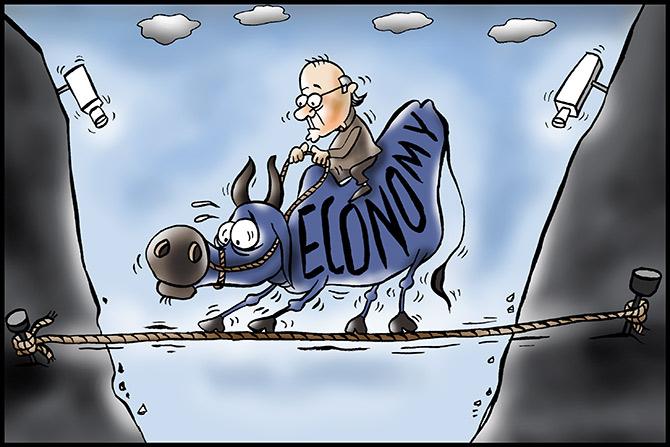Mihir S Sharma outlines why this year's Union Budget does not respond to the needs of India's economy, or attempt to frame the economy's future.
Illustration: Uttam Ghosh/Rediff.com

Three weeks on, the initial responses to the Union Budget for 2017-18 have faded, and have largely been replaced by puzzled head-scratching.
Unlike the last Budget, this one does not seem to represent the same sort of forward movement. It does not respond to the needs of India's economy, or attempt to frame the economy's future; it is, in its essentials, its mathematics and its thrust, entirely shaped by demonetisation alone.
This is unfortunate.
For the Budget was supposed to help India recover from the damage that that ill-conceived and poorly-implemented decision had done to the economy. Instead, it -- perhaps understandably -- was forced to be simply responsive, in the manner of much government policy since November 8.
The Budget was framed under difficult circumstances to start off with, even without demonetisation coming into the picture.
The precise nature of the revenue flow for next financial year is already deeply uncertain, since the Goods and Services Tax is due to come into force on July 1.
Demonetisation and the pushing forward of the Budget presentation by a month have made the ongoing financial year's numbers uncertain as well.
This fact is made strongly apparent in the Budget's somewhat ridiculous 'revised estimates' for corporate and personal income tax in 2016-17, which are almost exactly the same, down to decimals, as were predicted in the Budget last year -- a truly impressive feat of forecasting, if they are to be believed.
More worrying is that the confusion about this year's numbers makes predicting next year's doubly difficult.
Quadruply difficult, when you take into account the fact that the whole tax system is being overhauled come July. Yet the Budget's accounts seem almost to pretend as if the GST does not exist.
What does this mean -- that there will be another set of accounts released on July 1, with a new -- and presumably much less attractive -- fiscal deficit number?
Or that for three-fourths of the year we will be operating on obsolete Budget outlays? Or is the government no longer committed to the GST?
The broad thrust of the policies outlined in the Budget continues to be the one enunciated by the prime minister in his speech to the nation on New Year's Eve: Basically, an attempt to recover some of the political losses of demonetisation and capitalise on the political gains.
After many years, India has returned to a soak-the-rich, garibi hatao mentality -- most visible in the choices over personal income tax.
I do not intend to argue why or why not this political choice is wise. The point is merely that it is not where the economy, from the point of view of growth, should perhaps be going at the moment.
A forward-looking Budget that was not subject to the political diktats emerging from the prime minister's office after demonetisation would no doubt have, first and foremost, sought to restore the confidence of private investors.
Unfortunately, this important consideration has dropped by the wayside.
In fact, in some important respects, the Budget will have further disheartened private capital.
It is worth noting the exact nature of the problem that India's economy faces.
Growth is slower than it should be because private investment has continued to decline for several quarters. Unless private investment recovers, growth will not recover -- and jobs will not be created.
Till now, the government's strategy has been to throw public money at investment, to fill in the gaps. That will not be enough to restore growth directly, of course; private investment dwarfs public investment.
The hope is that productive capacity created by public investment will help private investment appear more attractive, and thus restore investor confidence.
Unfortunately, although this strategy has been tried for three years now, it does not seem to be working. Clearly, other constraints are continuing to bind.
One such is the state of the banking sector. Flush with funds after demonetisation or not, it is still undercapitalised and thus unwilling to lend.
The Budget did not exactly choose to move sharply on recapitalising the banks, setting aside only ₹10,000 crore (₹100 billion) for it.
Further, until genuine bank reform is implemented, it is difficult to see how public sector banks will scrape themselves out of the hole they are in at the moment.
Yet, the Banks Board Bureau announced with such fanfare has gone silent, its head now busying himself with the far more important problem of Indian cricket.
Meanwhile, instead of focusing on making public sector banks more professional and able to lend, the government has instead decided to use them as primary implementers of the prime minister's agenda, from the MUDRA small loans to the Jan Dhan Yojana to demonetisation itself.
Finally there is the question of demand for loans.
The basic problem underlying the fall-off of private investment continues to be avoided -- perhaps undiagnosed. Investor confidence has been subdued for years not because people do not expect India to grow, or because there are no possible projects with reasonable returns around.
It is because the problems of the past investment boom have not yet been sorted out, and because investors do not feel assured that such problems will not recur.
The problems of the past investment boom express themselves in this mechanism essentially as the debt on corporate balance sheets and the assets stranded in unproductive or stalled investment.
Deciding how to extract those assets, and how to clean up that debt, requires working banks and dispute resolution.
Three years in, in spite of the bankruptcy Bill being passed, there is no sign of this government having any more political resolution than the last one on deciding who takes haircuts on past investment and why, and through what process.
The paralysing fear of corruption in any such decision is still with us, and little has been done to overcome the paralysis.
And finally, investors do not feel assured that such problems will not recur.
They believe that much of the errors of the past years, leading to stalled investment and lost capital, came from arbitrary government action, whether regulatory or tax-related.
The government's priority should have been legislative and institutional reform that reduced arbitrariness. Instead, we have been treated to three years of assurances and investor melas -- words from officials that have been met, fittingly, by words from investors and not their money.
And now we have demonetisation, the turn to anti-rich populism, and the further empowerment -- in the Budget, among other places -- of the tax official.
This has made investors less, not more confident, and reduced the chances that the economy will reach the high-growth trajectory officials have often promised.
In other words, the Budget has moved the Indian economy backwards, and not forwards.
At this time, we can hardly afford that.












 © 2025
© 2025